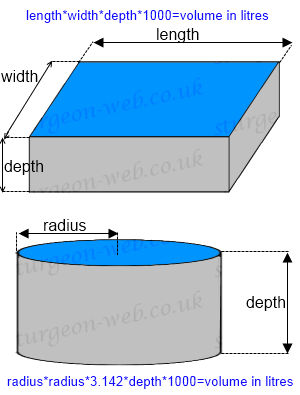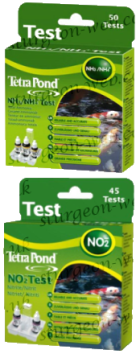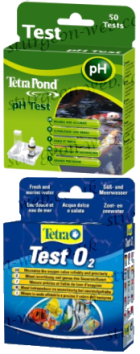Water Quality
A note to the clear water people; while clear water is a bonus it does not follow that because the water is clear it is OK. Think about the following...![]()
Customer says: 'my water is clear so it must be OK'
My answer: 'Sulphuric acid is clear but would you put your fish in it?'
Oxygen, while I bang on about it and getting a test kit I still have to tell people every day why the sturgeon die and other fish live. They do not tolerate levels as low as other fish will. Please buy an oxygen test kit and use it! You cannot look at a pond and say how high the oxygen level is hence test kits were made!![]()
Once open liquid test kits generally only produce accurate results for 6 months. After this it may not be possible to rely on them so use them, don't waste them. Keep a record so you know what is happening. This shows trends starting such as declining hardness, which can lead to a pH crash.![]()
6 in 1 test strips are a quick and simple way to test pH, nitrite, nitrate, GH, KH and Chlorine, just dip in the water and match the colour strips.
Buy water test kits from Orchard Fisheries »
pH Crashes
Recently a number of people have been reporting pH problems.
A Few facts:
- pH is based on a logarithmic scale i.e. 7.0 is 10 times less acid than 6.0
- The hardness (that buffers the pH) is naturally 'used' by bacteria in the natural process of nitrification.
- Acid rain; unless you have rainwater running in to your pond this should not have much effect.
- A stable pH is better than a variable one even if it is at the limit tolerated by the fish.
- To help reduce downwards pH fluctuations use crushed oyster shell in the filter. This can be purchased from Feed Merchants normally £6-£10 for 25kg (it is the same product sold by koi dealers for 10 x the price).
- Never change more than 1 pH point per day unless absolutely necessary.
- Ammonia is not toxic if the pH is below 7.0
- A low pH (less than 7.0) also reduces the nitrification process.
- Salt (sodium chloride) does not increase the pH.
![[This work is copyright © 2000-2024 www.sturgeon-web.co.uk]](img/copyright.gif)
Ideal Pond Levels for sturgeon
- pH 6.5 - 8.0
- Total Hardness (CaCO3) 50-400 ppm
- Oxygen (02) > 6mg per litre
- Ammonium (NH3) < 0.01 mg/litre
- Nitrite (NO2) < 0.1 mg/litre
- Nitrate (NO3) < 100 mg/litre
- Optimum temperature range 4°C to 25°C
- Optimum growth 22°C
![[This work is copyright © 2000-2024 www.sturgeon-web.co.uk]](img/copyright.gif)
The most important are Oxygen, Ammonium and Nitrite. But check all of them!
Pond Volumes
The best way to be certain of your pond volume is to use a meter when you fill it, especially if it's not a uniform shape and depth. Knowing the accurate volume is important if you need to use medications. Here are the basic formulas based on uniform shapes/depths:![]()
How to work out your pond volume:
- Square/Rectangular Pond Volume Metric
Length x width x depth = volume in Cubic Metres. 1 cubic metre = 1000 Litres.
Length x width x depth x 1000 = Volume in Litres - Square/Rectangular Pond Volume Imperial
Length x width x depth = volume in Cubic Feet. 1 cubic foot = 6.23 Gallons.
Length x width x depth x 6.23 = Volume in Gallons - Round Pond Volume Metric
Radius x Radius x 3.142 x depth = volume in Cubic Metres. 1 cubic metre = 1000 Litres.
Radius x Radius x 3.142 x depth x 1000 = Volume in Litres - Round Pond Volume Imperial
Radius x Radius x 3.142 x depth = volume in Cubic Feet. 1 cubic Foot = 6.23 Gallons.
Radius x Radius x 3.142 x depth x 6.23 = Volume in Gallons![[This work is copyright © 2000-2024 www.sturgeon-web.co.uk]](img/copyright.gif)

Pond volume calculations
Conversions:
- 1 Imperial gallon = 4.54609188 litres
Gallons x 4.54609188 = Litres - 1 litre = 0.219969157 Imperial gallons
Litres x 0.219969157 = Gallons
A pond example:
In feet:
28 ft x 14ft x 4 1/2ft deep = 1764 cubic ft
So Number of gallons 1764 x 6 1/4 =11025 gallons.
In metres:
8.60 x 4.30 x 1.38 = 51.03 m3
= 51030 litres or 51.03 x 220 (gallons per m3) = 11023 gallons
There is a small difference in the volumes due to the fact that I have rounded the figures off to the nearest whole number.
If you can't do it don't guess, ask a friend to work it out for you.![]()
Written by Terry White & Graham Quick
Contents
Home
Sturgeon Species
Sturgeon Care
Sturgeon Health
Water Quality
Our Other Sites

Copyright © 2000-2024
www.sturgeon-web.co.uk
All Rights Reserved.
Protected by UK Copyright Service Registration No:311386


